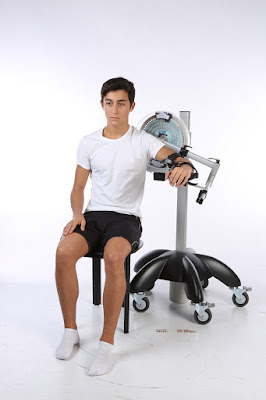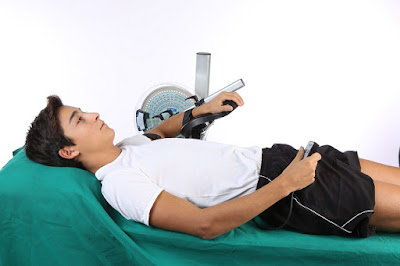Fisiotek HP2
your partner for passive rehabilitation of upper joints
your partner for passive rehabilitation of upper joints
Fisiotek HP2 has met, since its creation, good appreciations by the health care and health professional's world. For reasons that are connected to quality, Fisiotek HP2 has demonstrated, during years, an excellent reliability and precision in the final results.
A creation of Rimec, Fisiotek HP2 has been studied with the aim to cover a wide range of needs in passive rehabilitation, especially because it cover all the major upper joint as shoulder, elbow and wrist (Picture 2).
Only one device for physical therapy: it has been designed in order to provide a complete solution for whom that treat different patologies (surgical's one or not surgical) for the upper limbs: this is only thanks to the wide choice of accessories that are available (as optional) for this device.
Flexibility: it gives the possibility to operate both with patient in seated than in supine position. This is an excellent point of beginning, because it provide more confortable position for the patient. This possibility is enriched by the wheeled carriage, which allow to move the device everywhere.
Wide range of movement: being able to treat all the major upper joints, Fisiotek HP2 cover the complete physiological range through differents movements for each articulation (Picture 1):
- Shoulder: elevation - adduction/abduction - rotation (internal/external)
- Elbow: flexion/extension - pronation/supination
- Wrist: deviation - flexion/extension
Picture 1
Customization: this CPM device boast the opportunity to treat differents patient, even if they don't have to follow the same rehab session. Thanks to the Memory Card system, Fisiotek HP2 offer data memorization of all the parameters set; for this reason, it's possible to have one card for each patient.
Precision and reliability: HP2 mobilizer offers excellent stability thanks to the weight.
It's precise, because it uses a pointer laser for the correct correspondence with the rotation centers of the joints, and extremely reliable over time, because it not requires periodical maintenance or checks.
Fisiotek HP2 is available for customers who have physiotherapy centers, rehab clinics, physical therapy structures, and for all the professionals in Rehab field who need a perfect combination between quality, durability and reliability.
Picture 2
Picture 3
your partner for passive rehabilitation of the shoulder
The increasing number of installations of Fisiotek LT
shows an excellent usefulness for shoulder's rehab
Since its creation, Fisiotek LT has been thought to be a simple device for passive rehabilitation of the shoulder, as it as the recent technological breakthrough of surgical techniques require to recover the mobility briefly and easily.
Always more structures for rehabilitation and physiotherapy services require to have a CPM device for the shoulder able to work in every condition, in case of a young sportman or in case of an old patient who have to recover after an intervention of joint replacement.; in this cases, the device "come near the patient" accepting to work in all the scapular plans of the shoulder.
Following what is required by most of the standard rehab protocols for the shoulder, Fisiotek LT permit to have available all the complete range of movements, like elevation, adduction/abduction, and internal/external rotation.
Which are the differences between LT and the others model on the market?
1) no limits of space for patient positioning: in addition to seated position, it's possible to treat in supine position which is preferable because it provides a more comfortable posture;
2) no pre-installed programs but simple setting of parameters and features: manual reset of the parameters for movement's changing;
3) greatest facility without give results up;
4) availability of all the most important movements required in a rehabilitation protocol of the shoulder, as the elevation, the adduction/abduction, the internal-external rotation;
Following recent statements, it's appeared that Fisiotek LT can provide excellents results both in the post-operative period after orthopeadic surgery, both for physiotherapy programs after joints injuries.
Fisiotek LT is also appreciated for domestic use; often patients dismissed from hospitals, are expected to follow a passive rehabilitation's program for maximum 3 weeks after the intervention.
In effect, boasting the possibility to work with batteries, Fisiotek LT is also appreciated for its versatility; it can be used also with a 12V battery, rechargeable in 1 hour, and able to work for 2 hours and 30 min. Alternatively, it can work with a current cable.

Fisiotek LT-G & LT-P
Deatails of the movements with patient in sitting position
Details of the movements with patient in supine position

ADD-ABD movements in seated position
Elevation movement
Internal-external rotation movement
NEW Fisiotek LT for elbow and wrist
As part of the series for the upper limb, we have introduced Fisiotek LT-G for elbow and Fisiotek LT-P for the wrist, enriching the line with two new devices completely dedicated to a respective joint.
Both of the models have been though to be used with the patient in sitting position.
Every model has the possibility to program the R.O.M. referring on a precise scale reported on the rotor, which help to set the angle of work: this adjustment is made electro-mecanically and differently from left to right limb.
The scales of reference for each movement can be found reading the colour and switching the cursors along the rotor, up to the programming of an angle of work.
In the images below, we see the coloured scales for each movement:
For the elbow:
- pronation - supination
- flexion - extension
For the wrist:
- ulnar-radial deviation
- flexion - extension
 |
| Pic. 1 - Scales for elbow's movement |
 |
| Pic. 2 - Scales for wrist's movements |
To positionate the patient, it's possible to adjust the height of the device sliding the pin along the bar and inserting it in a free splint (Pic. 3): then, to lock the position, it's necessary to tighten the black knobs (Pic. 4).
 |
| Pic. 3 - System to adjust the height |
 |
| Pic. 4 - Knobs to lock the position in height |
Available movements for Fisiotek LT-G
Pronation-Supination: the arm have to stay adducted at 90° to the body of the patient and perfectly in-line with the center of rotation of the device (Pic. 5, red line)
 |
| Pic. 6 - Alignment of the arm to the center of rotation |
 |
| Pic. 5 - Correct position of the arm for elbow pronation-supination's movement |
Flexion-Extension: the bicep has to lean against the plastic support and the hand has to grab the handgrip. The handgrip for the hand can be slid along its rail.
For this movement, it's necessary to verify the correspondence of the elbow's joint to the center of rotation of the device. Even in this case it's preferable to keep the arm adducted at 90° to the body, in order to be sure to make move the elbow and not the shoulder.
 |
| Pic. 7 - Correct position of the arm for elbow flexion-extension's movement |
Available movements for Fisiotek LT-P
Flexion-Extension: with the arm adducted to the body and the forearm leant against the support, the hand has to be "locked" between the two handgrips of the accessory. In this case the joint of the wrist has to be aligned with the center of rotation of the device.
 |
| Pic. 8 - Correct position of the arm for wrist flexion-extension's movement |
 | |
Complete set of accessories
|
























Nessun commento:
Posta un commento